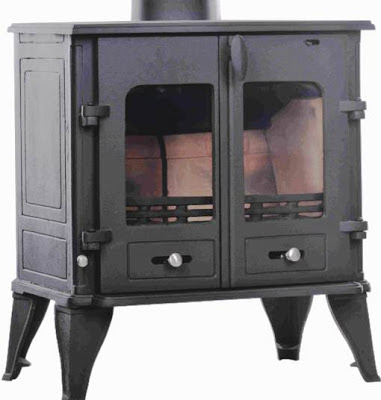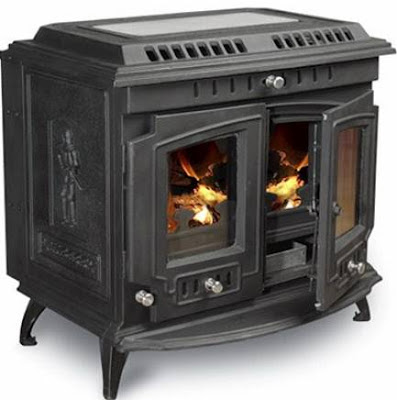.
A Review of
Multi-Fuel Stove Features
Part 3
Some General Design Features
What to Avoid
Take a good look at the stove in the above photo of a double door stove. It has several design features that I would avoid at all costs. Why would I avoid this type of design? There are two main reasons, actually there are more than two reasons, but for clarity in this post, I will stick to just the two.
1. Double doors: There is no practical need for two doors in the average size of stove. The only excuse for having double doors is in a very large stove perhaps upwards of 12Kw. Two doors are simply a style element, and one which generally causes problems. A single door will give the same access without the complications.
Two doors means a more complex closure with nearly half as much again of seal needed and therefore more places for air to leak in, and a lot more complicated when replacing the seals.
Air leaking into a stove spells trouble and causes problems. It can create hot spots of burn - like a little blow lamp - think of blowing to start a fire. A thin stream of air will cause fuel where it strikes to burn brighter. Air leaking in any crack in the seal between the two doors will create a hot spot of burn and this can lead to damage of the grate or retainer.
Air leaks also means that it is more difficult to control the general burn rate of the fire, this leads to inefficiency or overheating.
The seal between the two doors is right slap in the middle of the fire - the hottest place - it is going to be difficult to maintain a good seal at the best of times - but the roasting heat on the doors is going to cause some expansion of the metal and some warping.
Many double door stoves have only one latching point, in that case, it is next to impossible for there to be a good air seal.
Double doors generally means double air controls - more difficult to control the burn rate - quite simply put - a pain in the ass!!
In the slightly better design of double door stoves above, there is a top and bottom latching system. There still exists in this stove the second major design problem.
2. Sliding air controls: It is next to impossible to get any sort of fine adjustment of the air supply with sliding air controls. The rotary type of air control, if they are of reasonable quality, can give you an almost infinite degree of control of the air supply to the point of cut off. You will never get this with sliding controls.
Additionally, sliding air controls are usually spring loaded and slide areas can become clogged or corroded this leads to the tendency to stick making them very annoying to adjust.




No comments:
Post a Comment